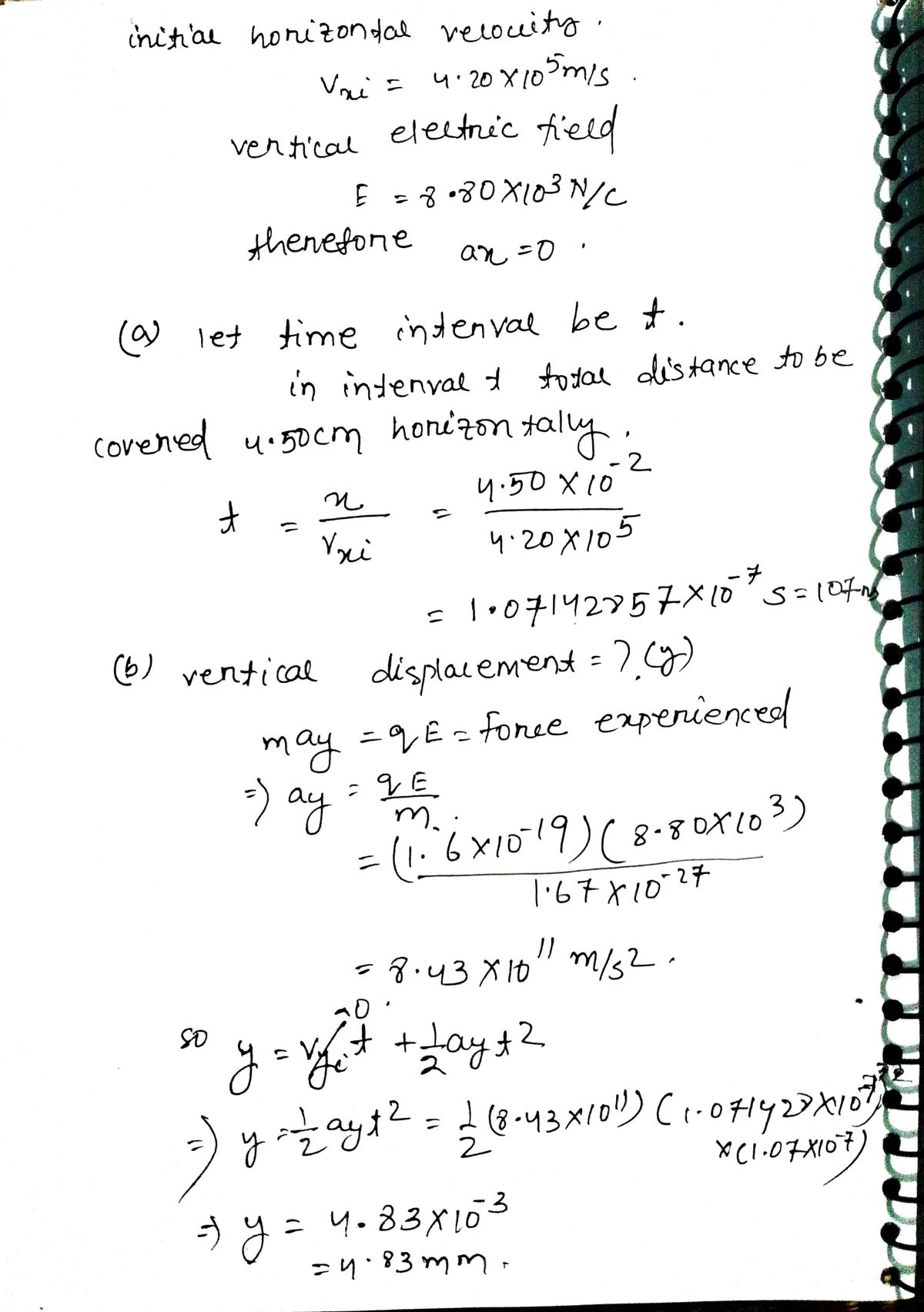A proton moves at 4.20 x 105 m/s in the horizontal direction. It enters a uniform vertical electric field with a magnitude of 8.80 x 10³ N/C. Ignore any gravitational effects. (a) Find the time interval required for the proton to travel 4.50 cm horizontally. 107 ✓ ns (b) Find its vertical displacement during the time interval in which it travels 4.50 cm horizontally. (Indicate direction with the sign of your answer.) 4.83 mm (c) Find the horizontal and vertical components of its velocity after it has traveled 4.50 cm horizontally. -(0.0042 xi + 0.00902 x j km/s
A proton moves at 4.20 x 105 m/s in the horizontal direction. It enters a uniform vertical electric field with a magnitude of 8.80 x 10³ N/C. Ignore any gravitational effects. (a) Find the time interval required for the proton to travel 4.50 cm horizontally. 107 ✓ ns (b) Find its vertical displacement during the time interval in which it travels 4.50 cm horizontally. (Indicate direction with the sign of your answer.) 4.83 mm (c) Find the horizontal and vertical components of its velocity after it has traveled 4.50 cm horizontally. -(0.0042 xi + 0.00902 x j km/s
Related questions
Question
![A proton moves at \(4.20 \times 10^5 \, \text{m/s}\) in the horizontal direction. It enters a uniform vertical electric field with a magnitude of \(8.80 \times 10^3 \, \text{N/C}\). Ignore any gravitational effects.
(a) Find the time interval required for the proton to travel \(4.50 \, \text{cm}\) horizontally.
\[107 \, \text{ns} \]
(b) Find its vertical displacement during the time interval in which it travels \(4.50 \, \text{cm}\) horizontally. (Indicate direction with the sign of your answer.)
\[4.83 \, \text{mm} \]
(c) Find the horizontal and vertical components of its velocity after it has traveled \(4.50 \, \text{cm}\) horizontally.
\[
\vec{v} = (0.0042 \, \hat{i} + 0.00902 \, \hat{j}) \, \text{km/s}
\]](/v2/_next/image?url=https%3A%2F%2Fcontent.bartleby.com%2Fqna-images%2Fquestion%2Fe6e52c04-e2c3-4e2d-83a7-f5740c8e0fd5%2Fe01f556b-f235-4cf9-9b87-9565051c748a%2F3ak1svl_processed.jpeg&w=3840&q=75)
Transcribed Image Text:A proton moves at \(4.20 \times 10^5 \, \text{m/s}\) in the horizontal direction. It enters a uniform vertical electric field with a magnitude of \(8.80 \times 10^3 \, \text{N/C}\). Ignore any gravitational effects.
(a) Find the time interval required for the proton to travel \(4.50 \, \text{cm}\) horizontally.
\[107 \, \text{ns} \]
(b) Find its vertical displacement during the time interval in which it travels \(4.50 \, \text{cm}\) horizontally. (Indicate direction with the sign of your answer.)
\[4.83 \, \text{mm} \]
(c) Find the horizontal and vertical components of its velocity after it has traveled \(4.50 \, \text{cm}\) horizontally.
\[
\vec{v} = (0.0042 \, \hat{i} + 0.00902 \, \hat{j}) \, \text{km/s}
\]
Expert Solution
Step 1

Step by step
Solved in 2 steps with 2 images
